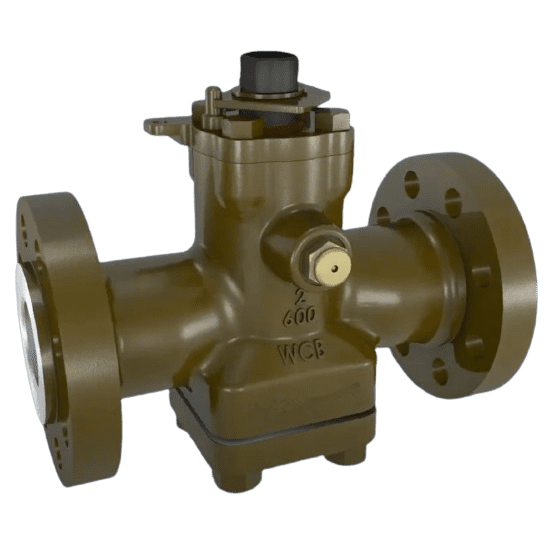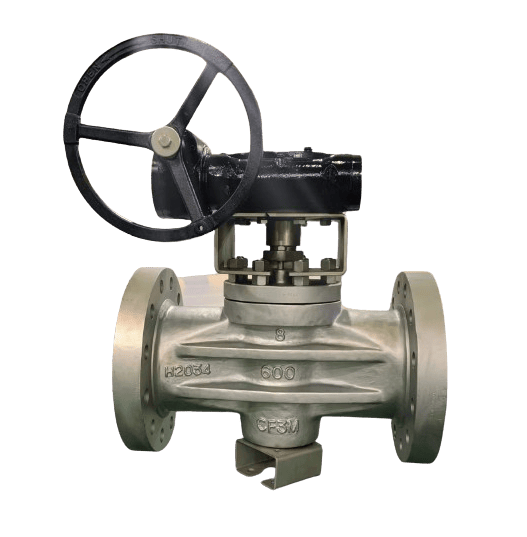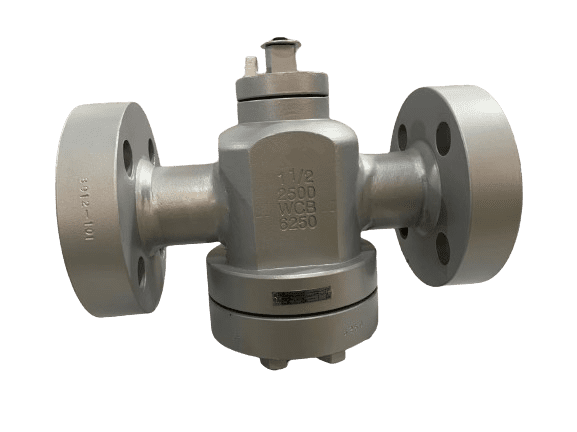Plug Valve Manufacturer
Only unexpected, nothing impossible
WHO IS PLUG VALVE ?
A plug valve is a type of valve that controls the flow of fluid through a pipe by using a cylindrical or conical “plug” that can be rotated inside the valve body. The plug has one or more passageways (called ports) that allow fluid to pass through when aligned with the valve body. When the plug is rotated, it can block or redirect the flow, making the plug valve useful for on-off control, flow regulation, or diversion of fluid streams.
PLUG VALVE Series

Lubricated Plug Valve

Non Lubricated Plug Valve

Lifting Plug Valve

High Pressure Plug Valve

API Plug Valve

Customized Your Plug Valve
How Does Plug Valve Work ?
The process of using a gate valve is as follows:
The basic structure of a gate valve includes the valve body, gate, stem, and handwheel or actuator. The valve body, typically made of metal, contains the internal parts and provides connection points to the pipeline. The gate, a flat or wedge-shaped component, moves up and down to open or close the flow path. The stem connects the gate to the handwheel or actuator, transmitting motion. The handwheel or actuator is used to manually or automatically operate the valve.
During use, the valve is opened by turning the handwheel or operating the actuator. When the handwheel is turned clockwise, the stem raises the gate, gradually lifting it out of the flow path. As the gate rises, the flow path opens, allowing fluid to pass through the valve. When fully open, the gate is completely out of the flow path, minimizing flow resistance and pressure drop.
Plug Valve Main Components:
- Body: The main structure housing the internal components. Made from durable materials like stainless steel or cast iron, it connects to the pipeline and contains the flow passage.
- Seat: The sealing surface inside the valve body where the plug rests when closed. It ensures a tight seal to prevent leakage, often made from metal or PTFE.
- Plug: A cylindrical or tapered component with a hollow passage. It rotates to align with or block the flow, controlling fluid movement through the valve.
- Stem: A rod that connects the plug to the actuator or handle. It transmits motion, allowing the plug to open or close the valve, typically made of corrosion-resistant material.
- Bonnet: A cover that encloses the upper part of the valve body. It protects the stem and packing and provides a mounting point for the actuator or handle.
- Packing: Material used to seal the space between the stem and valve body. It prevents fluid leakage along the stem, typically made from PTFE, graphite, or elastomers.
- Handwheel/Actuator: The mechanism used to operate the valve, manually or automatically. It controls the position of the plug, regulating fluid flow through the valve.

Why Choose Plug Valve?
Plug valves have a straightforward design with fewer moving parts, making them compact and easy to install. Their simple construction reduces the risk of mechanical failure and minimizes maintenance requirements.
Plug valves provide quick and efficient on/off control with a simple 90-degree turn of the handle or actuator. This makes them ideal for applications where fast response times are crucial, such as in emergency shutdowns or process control.
The plug valve’s design allows for a tight seal when closed, preventing leakage. This is especially important in applications requiring reliable isolation, such as in pipelines carrying hazardous or high-pressure fluids.
Multi-port plug valves can direct flow in multiple directions, reducing the need for additional valves and piping. This feature is beneficial in systems where flow direction needs to be changed frequently or where space is limited.
Due to their simple design and fewer components, plug valves require less maintenance compared to other valve types. Lubricated plug valves, in particular, are easy to maintain and can be serviced without removing the valve from the pipeline.
When fully open, plug valves offer minimal flow resistance, ensuring efficient fluid flow through the pipeline. This helps maintain system efficiency and reduces energy consumption.
Certain types of plug valves, especially non-lubricated ones with resilient seating, provide bubble-tight shutoff, making them ideal for gas and vacuum applications where zero leakage is essential.
With the right material selection, plug valves offer excellent resistance to corrosion. This makes them suitable for handling aggressive chemicals or corrosive fluids, particularly in chemical processing industries.
Categorization of PLUG VALVE
By Design:
- Lubricated Plug Valve: These valves use a lubricant, typically a special grease, injected into the valve body to reduce friction and seal the valve. The lubricant fills the gap between the plug and the valve body, making operation smoother and providing a tight seal. Lubricated plug valves are suitable for handling abrasive and corrosive fluids.
- Non-Lubricated Plug Valve: These valves do not require lubrication. Instead, they use a sleeve or lining made of materials like PTFE (Teflon) or other elastomers to provide a low-friction seal between the plug and the valve body. Non-lubricated plug valves are commonly used in applications where the use of lubricants could contaminate the fluid, such as in chemical processing or food and beverage industries.
- Eccentric Plug Valve: In an eccentric plug valve, the plug is offset from the centerline of the valve, providing a camming action as it rotates, which helps to reduce friction and wear. This design allows for a tighter seal and is often used in applications with high-pressure or slurry services.
- Multi-Port Plug Valve: Multi-port plug valves have more than two ports and are used to divert flow in different directions or to connect multiple lines. They can have three, four, or more ports, allowing for various flow configurations. These valves are commonly used in applications requiring flow direction changes without additional piping.
By Operation:
- Manual Plug Valve: Operated by a handwheel, lever, or wrench, manual plug valves are straightforward and cost-effective, suitable for applications where automation is not necessary.
- Pneumatic Plug Valve: Operated by compressed air, pneumatic plug valves allow for quick and automatic control of the valve. They are often used in systems where rapid and frequent operation is required.
- Electric Plug Valve: Operated by an electric motor, electric plug valves offer precise and remote control of the valve position. They are ideal for integration into automated control systems.
- Hydraulic Plug Valve: Operated by hydraulic fluid pressure, these valves are used in heavy-duty applications where strong and reliable force is needed to move the plug, such as in high-pressure or large-diameter pipelines.
By Material:
- Metallic Plug Valve:: Made from metals such as stainless steel, carbon steel, or brass, metallic plug valves are used in applications requiring high strength, durability, and resistance to pressure and temperature extremes.
- Plastic Plug Valve: Constructed from materials like PVC, CPVC, or polypropylene, plastic plug valves are lightweight and resistant to corrosion, making them suitable for chemical processing, water treatment, and other applications involving corrosive fluids.
- Lined Plug Valve: The interior surfaces of the valve are lined with materials like PTFE or rubber, providing additional protection against corrosive or abrasive fluids. Lined plug valves are often used in chemical industries or in applications where the fluid could damage the valve body.
By Port Configuration::
- Two-Way Plug Valve: The most common type, two-way plug valves have a single inlet and outlet, controlling flow in one direction. They are used for simple on/off operations.
- Three-Way Plug Valve: Three-way plug valves have three ports and can be used to divert flow between two different outputs or to mix two incoming flows. They are often used in process systems where flow redirection is required.
- Four-Way Plug Valve: With four ports, these valves are used to control more complex flow patterns, such as diverting flow to multiple outlets or connecting multiple lines in a system.
By Sealing Mechanism:
- Soft-Seated Plug Valve: Uses a soft material, like rubber or PTFE, for the seat, providing a tight seal with minimal torque. These valves are ideal for low-pressure and non-abrasive applications.
- Metal-Seated Plug Valve: Features a metal-to-metal seal, which is more durable and suitable for high-temperature, high-pressure, or abrasive environments. Metal-seated valves are commonly used in industries like oil and gas, where robust sealing is necessary.
Most Popular Questions for
PLUG VALVE
Difficulty in operating a plug valve can be caused by several factors, including lack of lubrication, corrosion, or debris buildup in the valve body. Regularly lubricating the valve with a suitable grease, ensuring the valve is cleaned during maintenance, and using corrosion-resistant materials can help alleviate and prevent this issue. If the valve remains difficult to operate, the stem or plug might need adjustment or replacement.
Leakage in a plug valve can occur due to worn seals, improper seating of the plug, or damage to the valve body. To resolve this, inspect the seals for wear and replace them if necessary. Ensure that the plug is properly seated by checking the alignment of the valve components. If the valve body is damaged, the valve may need to be repaired or replaced.
A reduction in flow capacity can be caused by partial blockage within the valve, such as sediment buildup, or an improperly sized valve for the application. To restore flow capacity, inspect and clean the valve to remove any obstructions. Ensure the valve is correctly sized for the required flow rate, and consider whether the valve design is appropriate for the fluid being handled.
Sticking or jamming can occur due to corrosion, debris, or lack of lubrication. To fix this, disassemble the valve and clean any debris or corrosion from the plug and valve body. Lubricate the plug properly before reassembly. If corrosion is severe, the affected parts may need to be replaced with corrosion-resistant materials.
Wear on the seating surfaces can be minimized by ensuring the valve is used within its specified pressure and temperature limits and by regularly lubricating the plug. Regular inspections and prompt replacement of worn parts can also help maintain the integrity of the seating surfaces. Using a valve with a hard-coated plug or seat may be necessary in abrasive or high-pressure applications.
Stem leakage in a plug valve is often due to worn stem packing, improper installation, or thermal cycling causing expansion and contraction. To prevent this, regularly inspect and tighten the stem packing gland as needed. If the packing is worn or damaged, replace it with the correct type and ensure proper installation. For high-temperature applications, consider using packing materials designed to handle thermal expansion.
Unusual noise during operation can be caused by cavitation, high fluid velocity, or vibration within the valve. To address this, ensure the valve is correctly sized for the application and that the flow velocity is within recommended limits. If cavitation is suspected, reduce the flow rate or consider installing an anti-cavitation trim. Adding supports to the pipeline can help reduce vibration.
Preventing corrosion involves selecting valves made from corrosion-resistant materials, such as stainless steel or alloys suited to the fluid being handled. Regular maintenance, including cleaning and inspection, can also help detect early signs of corrosion. In highly corrosive environments, using plug valves with special coatings or linings can provide additional protection.
Improper sealing can result from wear on the plug or seat, misalignment, or debris lodged in the valve. Inspect the plug and seat for wear and replace them if necessary. Check the alignment of the valve components and remove any debris that may be affecting the seal. In some cases, re-lapping the seat may be required to restore proper sealing.
Extending the service life of a plug valve involves regular maintenance, proper lubrication, and ensuring the valve is used within its specified operating conditions. Periodic inspection for wear, corrosion, and alignment issues is essential. Using high-quality, appropriately selected materials for the valve’s construction and ensuring correct installation will also contribute to a longer service life.
Customized your Valves with EASY!
Tell Us What You Need
Input the valve information you need, such as size, pressure, material and so on.
Directly upload datasheets or drawings.
Get Quote & Solution≤18h
To get a quote in less than 18 hours and have projects executed more easily and procurement streamlined, pls complete this form.
Get Drawing & Datasheet≤24h
For the normal valves, we can provide the drawings or datasheets wihtin 24 hours. For the customzied valves or large project, provide the drawings or datasheet within 48 hours.
Get A Fast Quote
Don’t let delays slow down your operations. Click here to fill out our quick quote form. And we’ll get back to you with a price and delivery time as soon as possible.

